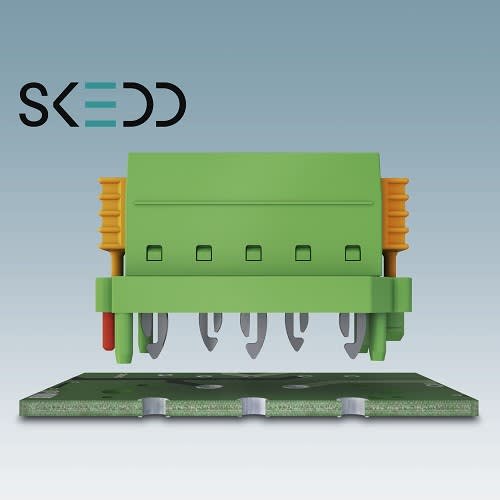A new concept in connection with SKEDD
Follow articleHow do you feel about this article? Help us to provide better content for you.
Thank you! Your feedback has been received.
There was a problem submitting your feedback, please try again later.
What do you think of this article?
Connectors are complicated things, and they almost always work in pairs. In the vast majority of cases, a connector depends on a mating half in order to operate, and this is one of the aspects that contribute to their complexity. Doubling up means twice the number of components, twice the volume of materials, twice the assembly operations and (usually) twice the cost.
There have been many attempts to reduce this dependancy, and make connectors cheaper and simpler. Some have worked better than others. Back in the late 90's, I was working for a leading connector manufacturer that was heavily involved in products for the mobile phone handset market. A design engineer from head office illustrated the scale of the problem by disassembling an old mobile phone. Back then, there were 10 pairs of connectors inside the average mobile handset. If the technology could be created to replace these pairs with single-piece connectors, there would be a clear saving.
There are some single-piece connectors available. From old transition plugs (quite an old technology) to more contemporary board-in contacts like the Molex SolderRight™, these products are designed to allow quick termination of cables straight to the PCB, but in strict terms, they are not true connectors. As the pins are soldered to the PCB, it is very hard to remove them later.
However, I recently discovered a new technology that Phoenix Contact are introducing into their connector range. It promises a direct plug-in solution that is different to the old transition or board-in connectors because they are removable. I was intrigued, and thought I would find out more.
The technology is called SKEDD, and it really does look like it lives up to the promise. It is designed to mate straight into plated-through holes on the PCB, and more importantly it is removable too. Even better, the connector is designed to be terminated without special tools. It even has locking latches, making the system vibration proof and suitable for a huge variety of applications. The video below explains it much more clearly - please take a look.
This approach offers a number of really useful advantages. The first should be obvious - we've halved the number of components required, offering a clear financial saving. But the savings go further. On modern, two-sided, surface mount PCBs, the fixing of a connector can sometimes require a supplementary operation. By removing the need for a fixed, board-mount connector, the manufacture of the PCB can be simpler and cheaper.
This type of connector could also have an influence on whole-life costs. If the PCB is faulty, a removable connector makes replacement much easier, keeping maintenance costs and down-time lower.
I think it's clear - I like these. It's not often that something new appears in the world of connectors, and this is one of those occasions.


